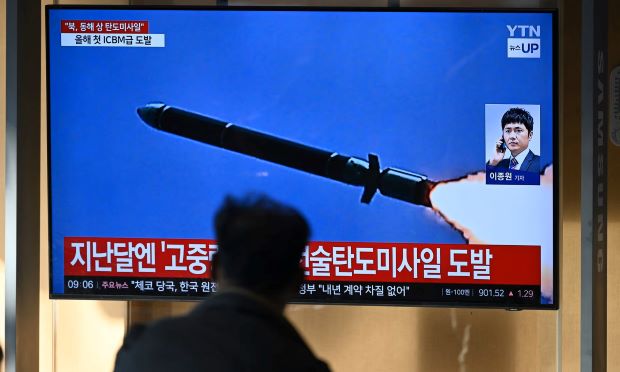North Korea launches long-range missile reaching unusually high altitude
By Choe Sang Hun
SEOUL — North Korea launched an intercontinental ballistic missile off its east coast Thursday, shortly after the United States and South Korea condemned the country for deploying troops near Ukraine to join Russia’s war effort.
The missile was fired from Pyongyang, the North Korean capital, at a deliberately steep angle so that it reached an unusually high altitude but did not fly over Japan, the South Korean military said in a brief statement. The missile landed in waters between North Korea and Japan.
The military said it was analyzing data to learn more about the missile, but that it believed it was an ICBM. North Korea last tested a long-range missile in December, when it test-fired its solid-fuelled Hwasong-18 ICBM.
North Korea confirmed later Thursday (Oct 31) that its military had launched an ICBM, saying that its leader, Kim Jong-un, had been present. North Korea “will never change its line of bolstering up its nuclear forces,” Kim was quoted as saying by the North’s official Korean Central News Agency.
The launch Thursday was the North’s first major weapons test since September when it fired a new type of Hwasong-11 short-range ballistic missile, which it said could carry a “super-large” conventional warhead weighing 4.5 tonnes.
On Wednesday, South Korean defence intelligence officials told lawmakers North Korea might conduct long-range missile tests before the US presidential election next week. They also said the North was preparing to conduct its seventh underground nuclear test, in a bid to raise tensions and gain diplomatic leverage with the next US president. North Korea conducted its last nuclear test in 2017.
In recent weeks, North Korea has posed a fresh security challenge to Washington and its allies by sending an estimated 11,000 troops to Russia to fight in its war against Ukraine. Thousands of them outfitted with Russian uniforms and equipment, have moved closer to the front lines, preparing themselves for possible battle against Ukrainian troops, South Korean and US officials said.
US Defence Secretary Lloyd Austin and South Korean Defence Minister Kim Yong-hyun met in Washington on Wednesday (Oct 30) for annual defence talks between the allies. They said they “condemned in the strongest terms with one voice” the cooperation between Russia and North Korea that “has expanded beyond transfers of military supplies to actual deployment of forces.”
Austin said he was increasingly concerned that Russian President Vladimir Putin planned to use the North Korean soldiers to support Russia’s combat operations in its Kursk region, where Ukraine has held territory since invading in August.
“Putin has gone tin-cupping to get weapons” from North Korea and Iran, Austin said. “Turning to a pariah state like North Korea for troops just underscores how much trouble he is in.”
Besides the troops, North Korea has sent 16,000 shipping containers full of artillery shells, rockets and missiles to Russia since the summer of last year, according to Washington and Seoul. When Putin met with Kim in Pyongyang in June, they restored a Cold War-era treaty of mutual defence and military cooperation between their countries.
That agreement raised fears in Washington and Seoul that Kim was forming an alliance with Russia to counter the one between South Korea and the United States, which also features a mutual defence treaty. In return for providing weapons and troops to Russia, North Korea was also seeking to get advanced technologies from Moscow to improve its missiles and satellite-launch programs, US and South Korean analysts said.
Days after Putin’s visit to Pyongyang, North Korea said for the first time that it had tested technology for launching several nuclear warheads with a single missile.
North Korea has launched several ICBMs in recent years, including ones with solid propellant that are easier to move and hide, and faster to launch, than its old liquid-fuel versions. But all of those missiles were fired at steep angles, rather than being sent across the Pacific.
North Korea has never demonstrated an ability to fire an ICBM on a normal, flatter trajectory. Another technological hurdle the North has yet to show it has cleared is so-called re-entry technology. After soaring into space, an ICBM warhead must endure intense heat and friction as it crashes back into the Earth’s atmosphere and toward its target.
-New York Times



Comments are closed, but trackbacks and pingbacks are open.